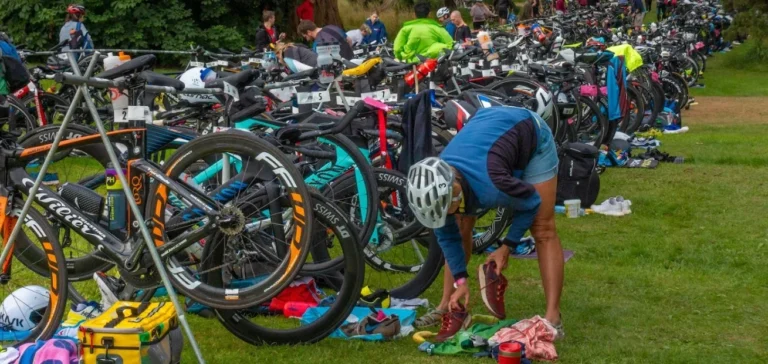Embarking on the journey of a triathlon is both exhilarating and daunting. One of the primary concerns for beginners is deciphering the appropriate attire for each segment of the race. Given that a triathlon combines swimming, cycling, and running, the attire must cater to the demands of each discipline while ensuring comfort and efficiency.
This guide aims to demystify the world of triathlon clothing for beginners, ensuring you’re well-prepared for race day.
Let’s begin!
The Tri-Suit: A Triathlete’s Best Friend
At the heart of triathlon attire is the tri-suit. This is a versatile piece of clothing designed to be worn throughout all three segments of the race. Made from quick-drying, breathable materials, it fits snugly to reduce drag in the water and air. A tri-suit comes in two primary styles:
- One-piece tri-suit: This is a single, integrated suit that covers the torso, extends into shorts, and typically comes with a built-in pad for cycling comfort.
- Two-piece tri-suit: Comprising separate top and shorts, this offers more flexibility and can be more comfortable for some athletes, especially during longer races.
RELATED: The Best Triathlon Men’s Suit For Beginners
RELATED: The Best Women’s Triathlon Suits
Diving into the Swim
When it comes to the swimming segment, the wetsuit reigns supreme, especially in cooler waters. Beyond providing the much-needed buoyancy and reducing drag, the wetsuit’s primary role is to insulate the athlete, preserving body heat. However, it’s crucial to invest in a triathlon-specific wetsuit. Unlike their generic counterparts, these are tailored to offer an optimal range of motion, particularly around the shoulders and arms.
RELATED: The Best Budget Triathlon Wetsuit
No swim is complete without the quintessential swim cap. More than just a tool to reduce drag, these caps, often color-coded by race organizers, serve a dual purpose. They ensure swimmers are easily identifiable in the water, providing an added layer of safety.
Lastly, the importance of a good pair of goggles cannot be overstated. They should nestle comfortably around the eyes, preventing water ingress without exerting excessive pressure. Features like anti-fog and UV protection can enhance the swimming experience, and for those sunny race days, a tinted pair might just be the perfect ally.
RELATED:
Pedaling with Precision in the Cycling Segment
Safety and efficiency are paramount in the cycling segment. The helmet is not just a protective shield but also an aerodynamic companion. It’s imperative to choose a helmet that snugly fits the head, ensuring safety without compromising on comfort.
RELATED: The Best Triathlon Helmet For Beginners
Sunglasses are more than just a style statement in triathlons. They shield the eyes from the sun’s glare, protect against gusty winds, and act as a barrier against any airborne debris.
When it comes to footwear, cycling shoes stand out. While seasoned triathletes might lean towards triathlon-specific variants, beginners can find solace in standard road cycling shoes. Their rigid soles are designed to optimize power transfer, ensuring every pedal stroke counts.
For those who seek added comfort, gloves might be a worthy addition. Beyond offering a superior grip, they come padded, cushioning the hands and reducing fatigue during longer stretches.
Racing to the Finish Line in the Run
The running segment is where the culmination of all the hard work is truly felt. A stellar pair of running shoes is the cornerstone here. They should offer a harmonious blend of support and cushioning, tailored to the athlete’s unique gait. To shave off precious seconds during transitions, consider shoes with quick-lace systems or elastic laces.
Protection from the elements continues to be crucial. A hat or visor can shield against the sun’s rays, while also serving as a sweat barrier.
Lastly, the humble race belt emerges as a game-changer. Instead of the traditional method of pinning the race number to the tri-suit, this belt allows for a swift transition between race segments, ensuring the number is always visible.
RELATED: The 5 best Triathlon Racing Belts
The Nuances that Make a Difference
Transitions in a triathlon are often dubbed the fourth discipline. It’s not just about swift clothing changes but also about nutrition, hydration, and gear management. Familiarizing oneself with the transition area layout and practicing gear switches can make a world of difference.
To ensure the tri-suit and other gear don’t cause discomfort, consider applying anti-chafing creams or balms to potential hotspots.
Speaking of gear, modern triathlon attire often incorporates pockets, perfect for storing energy gels or bars. It’s beneficial to have a nutrition and hydration strategy in place, taking into account the aid stations peppered along the racecourse.
Lastly, always be prepared for the whims of Mother Nature. Keeping an eye on the weather forecast can influence decisions, be it adding a layer or choosing specific accessories.
Concluding Thoughts
Choosing the right attire for a triathlon, especially for those new to the sport, can seem like navigating a maze. However, with the right guidance and a sprinkle of preparation, it transforms into an enjoyable aspect of the race journey. As you gear up for your triathlon adventure, may your attire complement your spirit, drive, and determination, propelling you to the finish line with flair and finesse.
